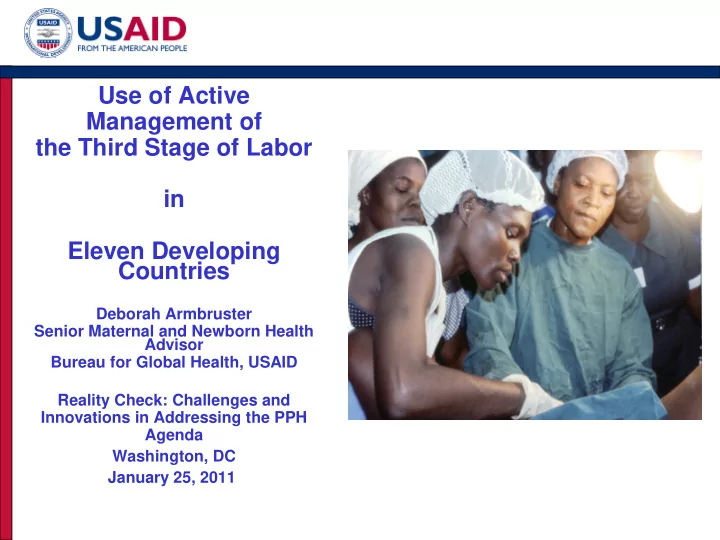

Use of Active Management of the Third Stage of Labor in Eleven Developing Countries Deborah Armbruster Senior Maternal and Newborn Health Advisor Bureau for Global Health, USAID Reality Check: Challenges and Innovations in Addressing the PPH Agenda Washington, DC January 25, 2011
Active Management of the Third Stage of Labor (AMTSL) What is AMTSL? • High impact, evidence-based intervention – 2 seminal RCTs and many additional studies support evidence – Reduces postpartum hemorrhage (PPH) by up to 60% • 3 components – Administration of a uterotonic agent (oxytocin is the drug of choice) – Controlled cord traction – Uterine massage after delivery of the placenta
History and Focus on AMTSL • 20 yrs of use in G. Britain and Commonwealth • Not used in US • USAID created PPH Initiative – Initial focus on AMTSL – Added community-based intervention with miso • 4 country projects, POPPHI, integration into MH projects • Is on the global agenda; many partners
AMTSL national surveys in 11 countries – 2005-2010 75 Indonesia 32 Ethiopia 29 With support, AMTSL coverage increased rapidly in Cirebon district Benin 17 of Indonesia Bangladesh 16 Tanzania 7 Guatemala National 7 coverage of Honduras 5 AMTSL is Uganda 5 low in all Ghana 3 countries El Salvador 3 Nicaragua 0.3 0 20 40 60 80 100 Percent National USAID ‐ Supported district POPPHI Project Multi-Country Survey. http://www.pphprevention.org/briefs_newsletters.php
Percent of observed deliveries w/ uterotonic given during 3 rd /4 th stages of labor and correct use of AMTSL (1 mn) 100.0 99.7 97.6 100.0 95.6 95.6 92.6 86.7 90.0 80.0 70.0 60.0 60.0 % o f d eliveries 50.0 40.0 31.8 29.0 30.0 22.8 20.0 7.1 6.7 10.0 4.5 2.6 0.3 0.0 Benin Tanzania Ethiopia El Salvador Guatemala Honduras Nicaragua Indonesia Received uterotonic 3rd/4th stage AMTSL (1 min)
Percent of observed deliveries with uterine massage following delivery of placenta 100.0 88.3 87.6 90.0 79.2 77.8 77.8 80.0 72.0 70.0 62.0 60.0 % o f d e liv e rie s 54.0 50.0 38.7 40.0 36.4 31.6 30.0 23.5 20.0 10.2 10.0 6.1 NA NA 0.0 Benin Tanzania Ethiopia El Salvador Guatemala Honduras Nicaragua Indonesia Immediate massage after delivery of baby Massage, plus palpation
Critical Elements for AMTSL Expansion Policies, POLICY guidelines, Awareness & protocols, endorsement standards in of national place expansion PROVIDER Standardized Improved All women are pre- & in- provider service knowledge, skills Reduced PPH offered and training & motivation Reduced receive PPH mortality prevention intervention LOGISTICS (DRUGS & SUPPLIES) Appropriate amount of Drug drugs procured, logistics appropriately stored, & in place available for all births MONITORING/SUPERVISION MIS & supervision system in place
Lessons learned: AMTSL • What is NOT so effective in increasing use of AMTSL? - ONLY changing policies - ONLY training providers - ONLY having drugs available - ONLY recording data and monitoring
Lessons Learned: AMTSL • Need creative and alternative ways to: - Increase the practice of AMTSL - Ensure competence of providers - Provide support & supervision - Ensure drugs are available for AMTSL - Record & collect data
Think outside the box • Try new innovations; engage your local partners to create solutions • Recognize the critical importance of the combined efforts of the MOH and all groups within a country to scale-up AMTSL for impact • Are we having an impact? Are we saving lives? We need indicators, record keeping and data collection efforts to let us know.
Noteworthy News and Issues • AMTSL trial ( WHO multi-centre (8)) will report results in early March 2011. Could find that controlled cord traction not needed • Oxytocin potency may be more of a concern that previously thought – watch for new study results to come out soon • Will that make oxytocin in Uniject with its TTI more popular? Will this push for increased use of misoprostol? • Miso is available, miso is being used… are providers and the public properly educated on its use?
Thank you Join us in Addis Ababa, Ethiopia Feb. 21-25 Africa Regional Meeting on Interventions for Impact in Essential Obstetric and Newborn Care
Recommend
More recommend